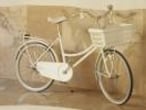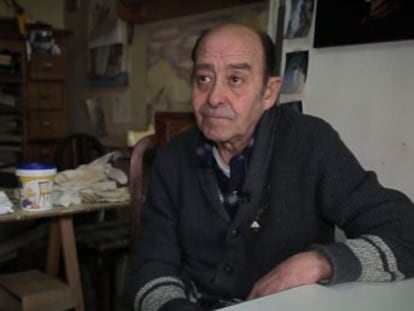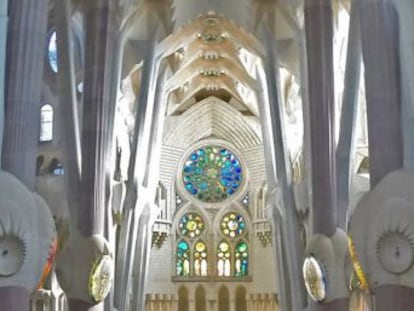Gaudí’s last tenant
The writer Ana Viladomiu is the only resident living in La Pedrera, a World Heritage building designed by the iconic Catalan architect and visited by over one million tourists a year
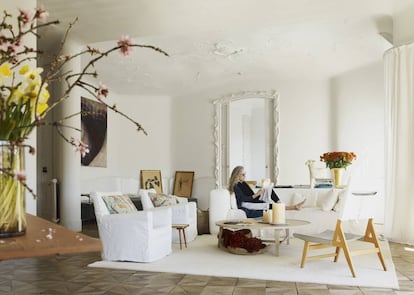
There’s a guard who asks where you are going, and a security barrier in front of the door. A Japanese tourist with a giant camera takes photos of you without asking, while around 12 people line up to enter the souvenir shop. The bottleneck of people makes it difficult to walk around the courtyard.
This is all pretty normal, considering we are in La Pedrera, otherwise known as Casa Milà, designed by the Catalan architect Antoni Gaudi between 1906 and 1912. Living in here, however, is anything but normal.
The writer Ana Viladomiu is the building’s sole remaining resident. Viladomiu has been living on the fourth floor or La Pedrera for the past 30 years. Once she was one of several tenants in this marvel of modern architecture that resembles a massive cake made from stone and wrought iron. Standing on the corner of Calle Provenza street and Paseo de Gracia, once a bourgeois neighborhood that has since morphed into a tourist playground, La Pedrera was commissioned by the flamboyant Catalan developer Pere Milà and his wealthy wife Roser Segimón in 1906, and was declared a World Heritage Site by UNESCO in 1984.
When I first arrived, it took me a while to get used to it
Author Ana Viladomiu
Today Viladomiu is no longer one of the residents of La Pedrera: she is the last. Apart from a woman named Carmeta who is never there, she is the only tenant who continues to live among the cast iron pillars, stone chimneys, bright and airy courtyards and security paraphernalia. She is like the last of the Mohicans, surfing a tsunami of global tourism that each year brings more than a million visitors to La Pedrera, which could be translated as “the stone quarry.”
When Viladomiu was looking for material for her third novel, she did not realize that the story was lying right in front of her – indeed she was inside it. A friend suggested the idea and from this meeting, Viladomiu set about interviewing more than 40 people linked to the building. She spoke with her friend, the journalist Carles Bosch, who came up with ideas central to the storyline, and then sat down to write La Ultima Vecina (or, The Last Resident), which was published in March by Roca Editorial.
Everything in Viladomiu’s apartment is a blinding white, from the sofas to the walls and curtains and carpets. It is the kind of home where you could use a pair of sunglasses. From the stark whiteness of the living room, you emerge into an equally white circular corridor leading to one of the two main courtyards, which act as the building’s backbone.
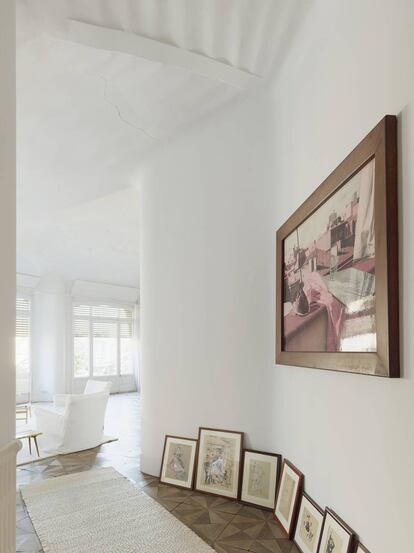
In an excerpt from Viladomiu’s novel, the character Martina Meseguer says of this passageway, “At night I love to walk down it and spend time looking through the windows, either at the terrace or the stars and the moon. It gives me a feeling of unreality, like being in a castle or in a beautiful fairytale.”
But not all of the building’s history is a fairytale. During the Spanish Civil War, the Workers’ Party of Marxist Unification (POCUM) seized the bottom of the building for its headquarters, while the United Socialist Party of Catalonia (PSUC) took over the main part of the building where Milà and Segimón had been living. Viladomiu suspects that her own apartment was turned into one of the terrible secret police checas where detainees were brought to be tortured and killed.
La Pedrera is one of the few buildings in the world with five different uses: commercial, administrative, social, cultural, tourist and residential. It has housed tailor shops, bingo halls, notaries, estate agents, hotels and consulates. It was also home to an Egyptian prince and his harem, not to mention the consultancy of the fortune teller Octavio Aceves.
It’s Big Brother UNESCO- style
Author Ana Viladomiu
“My idea from the start was to use La Pedrera as a backdrop,” says Viladomiu sitting in her enormous living room beneath a large painting by Miquel Barceló. “It’s where the characters lead their daily lives,but the building ends up being another character in the book– in fact, the most important one.”
The book was written as the building was being refurbished for a third time (the work finished in 2014), giving the author the perfect metaphor to describe her relationship with her home. One of the central themes of the book is erosion – the erosion of stone and of relationships, a tension that is both physical and literary. But this does not always lead to ruin, it can also give way to beauty. “That is at the heart of the novel,” says Viladomiu.
The discomfort and inconvenience of renovations lasted nearly a year. In the novel, Viladomiu writes: “The nightmare of the renovations in this house are over, as is the pain of our relationship.”
Beyond erosion there is angst, which as the novel says, “comes from within, not from without.” This reflects the threat faced by the novel’s main characters, Martina and Paul, the fictitious version of Viladomiu and Fernando Amat, the owner of Vinçon, a famous design shop on Paseo de Gracia that closed down in 2015.
Viladomiu and Fernando moved into the building 30 years ago, and it was here that the couple brought up their daughters, Nina and María, who are both now architects themselves. Unlike their mother, the children decided a long time ago to swap the surveillance of La Predrera for the anonymity of apartments in the El Raval neighborhood of Barcelona.
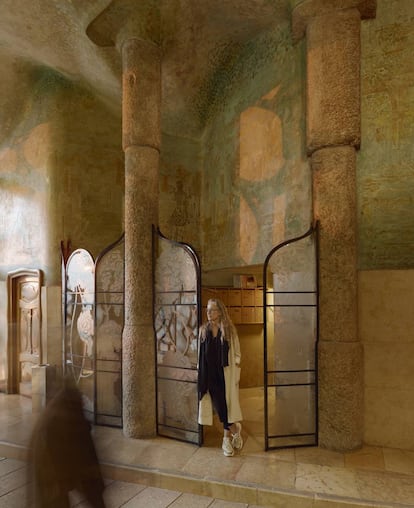
Fernando was the first to move to La Pedrera. He rented one of the famous 30-square meter duplexes that were designed by Barba Corsini, which the Caixa de Catalunya Foundation got rid of in 1986 when it acquired and renovated the building.
Viladomiu recalls half-amused and half-indignant, “The Caixa handed out millions of euros in compensation to some of the tenants to get them to leave, so much money that they left and bought their own homes. But we were never offered any money – I never found out why. I think they liked having us here as a curiosity, like Copito de Nieve [the albino gorilla] when he was in the Barcelona zoo.”
Living in La Pedrera has not always been easy. “I love this place now – the ceilings and floors, but it wasn’t always like that.” says Viladomiu, whose apartment qualifies for rent control. “When I first moved in, it took me a while to get used to it. It’s not an easy home to live in; I’ve made it mine bit by bit.”
Viladomiu suspects that her place was a secret police hideout during the Spanish Civil War
But Viladomiu is also able to see the funny side of having lived so many years of her life in a UNESCO World Heritage Site. “I remember weekend trips to the beach when the girls were little and we went out the door in our bathing suits, with rubber rings and water bottles and food containers [...] and the people who were visiting turned and stared at us. [...] Or when you come from the supermarket with loads of grocery bags,” she says. “Because you’re entering La Pedrera, not a normal apartment in a normal block, and you get looks. And if I stick my head out of one of the windows that look onto the patio, tourists take photos of me. It’s all very odd. And then there are the scanners and the security cameras that record everything, although I don’t give a hoot. It’s like Big Brother but instead of a VIP Big Brother, it’s Big Brother UNESCO-style.”
But some things have changed for the better over the years. “There was a time when the tourists came all the way up to the landing and they would ring the doorbell to see if they could come in and look around the apartment. Or they would sneak into the private elevator,” she says. “Basically, the kind of things we would try to do too if we went to Italy to see a historic building; we would try to leave the official tour and be a bit nosy, wouldn’t we? It’s very human. But now, there’s no one else here, and on Sunday afternoon and at nights it is deserted. Yesterday, a friend of mine left the house after spending a few days here and she said she found walking down the corridor at night scary.”
Viladomiu sometimes wonders what will happen to the apartment when she leaves or dies (she has a lease for life). “If they create apartments, they would have to rent them to Russian or Chinese millionaires because no one in Barcelona could afford them,” she says. “And then the people of Barcelona would be angry that a house that is an artistic heritage site is being rented to a wealthy tourist. It wouldn’t be politically correct.”
When Viladomiu gets home, she passes through security and says hello to the guards and the staff from the Catalonia-La Pedrera Foundation. Then she smiles at the Korean tourists and the children on a school trip. While some people go home to a mop and bucket standing in the lobby, she gazes at the tapestries and frescoes depicting the deadly sins, the heroes of the Trojan War and the adventures of Telemachus and echoes of Homer’s Illiad and Odyssey. In fact, Viladomiu’s 30 years in La Pedrera are something of an odyssey in themselves, and it is no wonder she has turned it into a novel. After all, she is the last tenant.
English version by Heather Galloway.

